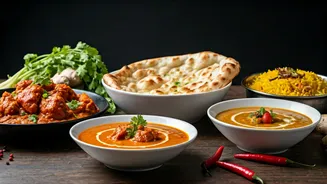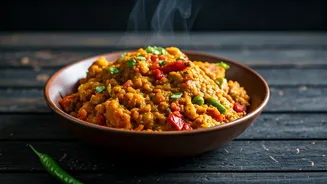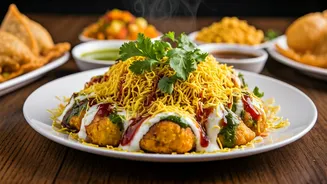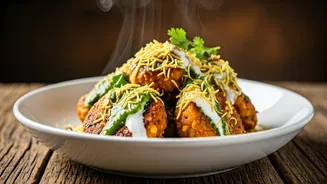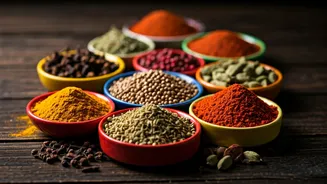Introduction to Punjabi Cuisine
Punjabi cuisine is characterized by its liberal use of dairy products, particularly ghee and butter, which impart a rich texture and taste. The cuisine also
features a diverse range of spices, contributing to its complex and delicious flavors. Popular ingredients include wheat, rice, pulses, and a variety of vegetables and meats. Punjabi food is not just about taste; it's about sharing and community, often enjoyed during celebrations and gatherings. The preparation methods also play a significant role, with many dishes involving slow cooking, grilling, and tandoor cooking to enhance the flavors. Moreover, the influence of the fertile lands of Punjab and the agricultural heritage of the region has deeply shaped the cuisine, offering a wide array of fresh and locally sourced ingredients. Furthermore, the cuisine adapts to both vegetarian and non-vegetarian palates, ensuring there is a dish for everyone to savor.
Classic Dal Makhani
Dal Makhani is a beloved Punjabi dish, known for its creamy texture and rich flavor. This slow-cooked black lentil and kidney bean dish is a staple in Punjabi households and restaurants. To prepare it, you soak black lentils and kidney beans overnight, then simmer them with butter, cream, and a blend of spices. The slow cooking process allows the flavors to meld, resulting in a velvety smooth consistency. The dish is typically garnished with fresh cream and served with naan or rice. Its popularity stems from its comforting warmth and the ability to offer a satisfying meal. The inclusion of spices like ginger, garlic, and garam masala elevates the taste, creating a dish that is both flavorful and aromatic. A well-made Dal Makhani is a true culinary indulgence, appreciated for its depth of flavor and creamy texture.
Aloo Gobi's Magic
Aloo Gobi is a simple yet flavorful dry vegetable dish made with potatoes (aloo) and cauliflower (gobi). The dish is cooked with onions, tomatoes, and a mix of aromatic spices like turmeric, cumin, and coriander. It is a vegan-friendly and readily available dish that is often a common choice for everyday meals. The potatoes and cauliflower are usually cut into bite-sized pieces and sautéed with the spices, allowing the flavors to penetrate the vegetables. This dish can be enjoyed with roti, paratha, or rice. The simplicity of the ingredients and the ease of preparation make Aloo Gobi a perfect choice for both novice and experienced cooks. It showcases the versatility of Punjabi cooking by taking ordinary vegetables and transforming them into a delightful meal.
Sarson da Saag & Makki di Roti
Sarson da Saag is a traditional Punjabi dish made with mustard greens (sarson), often paired with Makki di Roti (cornmeal flatbread). The saag is slow-cooked with a blend of spices, resulting in a slightly bitter yet flavorful dish. The makki di roti, made from cornmeal, has a unique texture and taste that complements the saag perfectly. This combination is a classic winter dish, known for its warmth and heartiness. The process involves thoroughly cleaning and chopping the mustard greens, then simmering them with spices like ginger, garlic, and green chilies. The makki di roti is prepared by mixing cornmeal with warm water and cooking it on a hot griddle. Both dishes together provide a balanced and deeply satisfying culinary experience, making it a favorite for many. Many homes and restaurants in Punjab embrace this comforting and flavorful combination.
Chhole Bhature's Delight
Chhole Bhature is a popular Punjabi dish consisting of spicy chickpea curry (chhole) served with fluffy, deep-fried bread (bhature). The chhole, or chickpea curry, is made with chickpeas, tomatoes, onions, and a blend of aromatic spices. Bhature are made from a dough of refined flour, which is deep-fried until golden and puffy. This dish is usually eaten as a complete meal, often enjoyed with onions, pickles, and green chutney. The combination of the spicy chickpea curry and the soft, fluffy bread makes for a flavorful and satisfying meal. The preparation of chhole involves soaking and cooking the chickpeas until tender, then simmering them with a rich gravy of spices. Bhature are made with a leavened dough, which contributes to their light and airy texture. Together, they create a tasty and much-loved Punjabi experience.
Paneer Dishes Galore
Paneer, a fresh Indian cheese, is a versatile ingredient in Punjabi cuisine, used in numerous dishes. Paneer Tikka Masala, for instance, involves marinated paneer cubes grilled and then simmered in a creamy tomato-based sauce, that’s rich and delicious. Palak Paneer features paneer cubes in a spinach gravy, offering a healthy and flavorful meal. Matar Paneer combines paneer with green peas in a tomato-based gravy, a simple yet enjoyable dish. The cheese can also be enjoyed in other preparations such as Paneer Bhurji (scrambled paneer), paneer kofta curry (cheese balls in a gravy), and many other flavorful variations. The flexibility of paneer and the flavorful spices used in these preparations give a hearty and tasty dimension to Punjabi cooking.
Vegetable Delights to Savor
Punjabi cuisine showcases a wide variety of vegetable dishes that offer diverse flavors and textures. Baingan Bharta, made from roasted eggplant, is mashed and cooked with onions, tomatoes, and spices, resulting in a smoky flavor. Vegetable Jalfrezi features a mix of fresh vegetables sautéed with onions, peppers, and tomatoes in a spicy, flavorful sauce. The Punjabi-style Dum Aloo has small potatoes simmered in a rich, creamy gravy. These preparations use fresh, seasonal vegetables and aromatic spices to produce balanced and appealing meals. The dishes highlight the diversity of vegetables used in Punjabi food and offer various ways to enjoy them. Each dish is a testament to the creativity and ingenuity of Punjabi cooking.
Tandoori Specialties
The tandoor, a traditional clay oven, plays a significant role in Punjabi cooking, especially when cooking dishes like Tandoori Chicken. This iconic dish involves marinating chicken in yogurt and spices, then cooking it in the tandoor for a smoky, tender taste. Tandoori items can be prepared with many ingredients, including various vegetables. Tandoori dishes have a smoky flavor and a slightly charred exterior, which creates a unique and unforgettable eating experience. The tandoor adds a distinctive taste to the meat and vegetables, making them aromatic and flavorful. This technique is more than just a cooking method; it is a fundamental aspect of Punjabi culinary tradition, which creates dishes that are tasty and culturally rich.
Rice and Bread Pairings
Punjabi cuisine offers a variety of rice and bread options that complement its main dishes. Jeera Rice, made with basmati rice and cumin seeds, provides a fragrant and flavorful accompaniment. Vegetable Pulao includes rice cooked with vegetables and spices, offering a complete meal. Naan, a soft, leavened flatbread, is a staple served with curries and gravies. Paratha, a layered flatbread often stuffed with potatoes, cauliflower, or other fillings, offers a richer, more satisfying option. The use of various grains and baking methods offers different flavors and textures, that give a hearty dimension to Punjabi cuisine, with rice and bread as staple accompaniments.
Sweet Endings: Desserts
Punjabi cuisine offers a variety of desserts to conclude a meal on a sweet note. Gulab Jamun, deep-fried milk balls soaked in sugar syrup, is a popular treat. Gajar ka Halwa, a carrot pudding, is made with grated carrots, milk, sugar, and nuts, offering a rich and creamy texture. Kheer, a rice pudding, is made with rice, milk, sugar, and cardamom, and is a comforting dessert. The desserts of Punjabi cuisine showcase the use of ingredients like milk, sugar, nuts, and dry fruits. These desserts are made to balance the spicy and savory flavors of Punjabi dishes. They are more than just a way to end a meal; they are an integral part of the Punjabi culinary heritage and cultural traditions.


